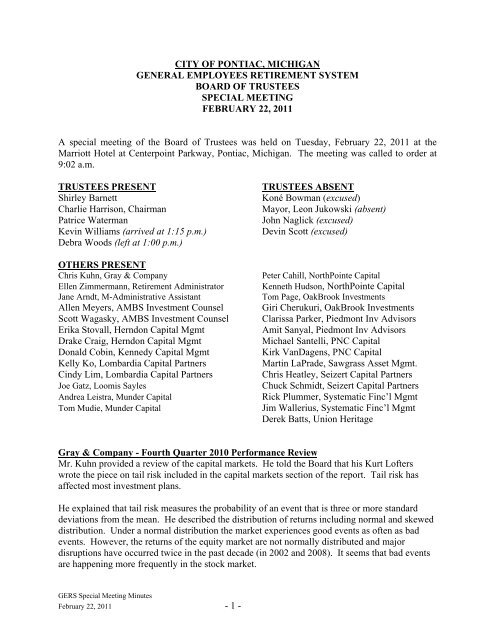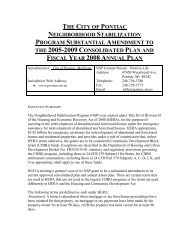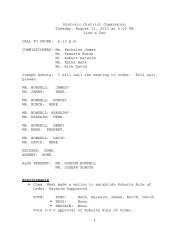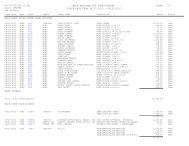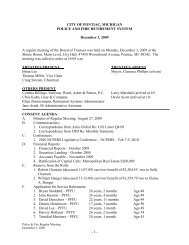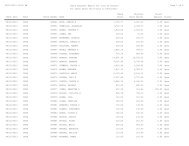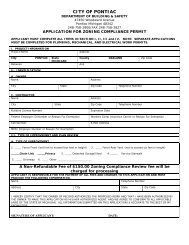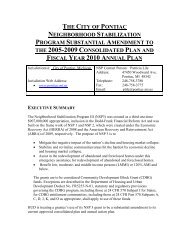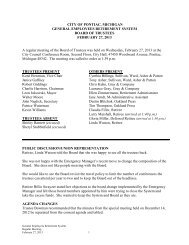You also want an ePaper? Increase the reach of your titles
YUMPU automatically turns print PDFs into web optimized ePapers that Google loves.
<strong>CITY</strong> <strong>OF</strong> <strong>PONTIAC</strong>, <strong>MICHIGAN</strong><br />
GENERAL EMPLOYEES RETIREMENT SYSTEM<br />
BOARD <strong>OF</strong> TRUSTEES<br />
SPECIAL MEETING<br />
FEBRUARY 22, 2011<br />
A special meeting of the Board of Trustees was held on Tuesday, February 22, 2011 at the<br />
Marriott Hotel at Centerpoint Parkway, Pontiac, Michigan. The meeting was called to order at<br />
9:02 a.m.<br />
TRUSTEES PRESENT<br />
Shirley Barnett<br />
Charlie Harrison, Chairman<br />
Patrice Waterman<br />
Kevin Williams (arrived at 1:15 p.m.)<br />
Debra Woods (left at 1:00 p.m.)<br />
OTHERS PRESENT<br />
Chris Kuhn, Gray & Company<br />
Ellen Zimmermann, Retirement Administrator<br />
Jane Arndt, M-Administrative Assistant<br />
Allen Meyers, AMBS Investment Counsel<br />
Scott Wagasky, AMBS Investment Counsel<br />
Erika Stovall, Herndon Capital Mgmt<br />
Drake Craig, Herndon Capital Mgmt<br />
Donald Cobin, Kennedy Capital Mgmt<br />
Kelly Ko, Lombardia Capital Partners<br />
Cindy Lim, Lombardia Capital Partners<br />
Joe Gatz, Loomis Sayles<br />
Andrea Leistra, Munder Capital<br />
Tom Mudie, Munder Capital<br />
TRUSTEES ABSENT<br />
Koné Bowman (excused)<br />
Mayor, Leon Jukowski (absent)<br />
John Naglick (excused)<br />
Devin Scott (excused)<br />
Peter Cahill, NorthPointe Capital<br />
Kenneth Hudson, NorthPointe Capital<br />
Tom Page, OakBrook Investments<br />
Giri Cherukuri, OakBrook Investments<br />
Clarissa Parker, Piedmont Inv Advisors<br />
Amit Sanyal, Piedmont Inv Advisors<br />
Michael Santelli, PNC Capital<br />
Kirk VanDagens, PNC Capital<br />
Martin LaPrade, Sawgrass Asset Mgmt.<br />
Chris Heatley, Seizert Capital Partners<br />
Chuck Schmidt, Seizert Capital Partners<br />
Rick Plummer, Systematic Finc’l Mgmt<br />
Jim Wallerius, Systematic Finc’l Mgmt<br />
Derek Batts, Union Heritage<br />
Gray & Company - Fourth Quarter 2010 Performance Review<br />
Mr. Kuhn provided a review of the capital markets. He told the Board that his Kurt Lofters<br />
wrote the piece on tail risk included in the capital markets section of the report. Tail risk has<br />
affected most investment plans.<br />
He explained that tail risk measures the probability of an event that is three or more standard<br />
deviations from the mean. He described the distribution of returns including normal and skewed<br />
distribution. Under a normal distribution the market experiences good events as often as bad<br />
events. However, the returns of the equity market are not normally distributed and major<br />
disruptions have occurred twice in the past decade (in 2002 and 2008). It seems that bad events<br />
are happening more frequently in the stock market.<br />
GERS Special Meeting Minutes<br />
February 22, 2011 - 1 -
He explained that some investors may manage their tail risk using risk parity. This strategy<br />
allocates less to equities and more to fixed incomes, such as reducing the equity allocation from<br />
65% equities to 50% and increasing the fixed income allocation from 35% fixed income to 50%.<br />
However, that allocation is not expected to achieve the performance target needed to meet the<br />
actuarial valuation. To achieve the needed performance the investors apply leverage to the<br />
portfolio. He gave an example of how investors leverage the investments in their portfolio by<br />
borrowing money using their assets as collateral to add to their investments. So instead of<br />
investing $1.00 for every $1.00 of assets, they are investing $1.50 in the same investment to<br />
achieve more returns. This works well in theory but may not work as intended under market<br />
stresses..<br />
Chairman Harrison asked if Mr. Kuhn is talking about margins. Mr. Kuhn said that it is called<br />
borrowing on margin and results in higher dollar allocations to fixed income and equity to<br />
increase returns.<br />
He gave an example of a core real estate investment manager that leases building to a<br />
government agency. The manager feels that this is a stable tenant and sells the investment as a<br />
low risk strategy but the buildings are leveraged at 80% to 90%. If the tenant leaves they would<br />
lose the building. An investment strategy should merit consideration based on the strategy and<br />
not solely on the enhancement provided by leverage.<br />
Chairman Harrison asked if the risk is higher and whether there are good plays in municipal<br />
bonds.<br />
Mr. Kuhn asked if the trustees had any questions regarding this investment approach.<br />
He reviewed inflation and Fed Policy. Inflation is mild at 1.5% which is a little below the Fed<br />
target of 2% to 3%. The commodity index is rose sharply with increases coming from<br />
agricultural products, such as grain prices. China continues to push up demand which has<br />
created a challenge keeping pace with global demands. They will continue to see this issue.<br />
The Fed has done very little to control inflation and has instituted policies to increase inflation.<br />
Historically, the Federal Reserve has used the Fed Fund rates as a key policy tool to manage<br />
inflation.<br />
QE2 was done to keep interest rates low and spur the economy.. However, investors moved<br />
money out of fixed income to equities and were rewarded with double digit returns.<br />
One-year equity returns delivered solid performance across all capitalization ranges and styles.<br />
Chairman Harrison asked if going forward these returns will flip flop.<br />
Mr. Kuhn said that coming out of a recession small cap stocks typically performs better than<br />
large cap stocks and later in the recovery large caps normally perform better than small caps.<br />
Performance was positive across all sectors. However, healthcare performance was poor at<br />
GERS Special Meeting Minutes<br />
February 22, 2011 - 2 -
2.94%. This is a defensive sector that tends to perform better when things are going wrong in the<br />
market.<br />
The shift in the yield curve was a bad sign for fixed income.<br />
Trustee Woods left at 9:16 a.m.<br />
Chairman Harrison asked about municipal bond buying opportunities. Mr. Kuhn said that there<br />
are tax advantages to investing in municipal bonds. Historically, they provide lower yields than<br />
taxable bonds due to their tax advantages. However, currently many municipal bonds are trading<br />
at a premium to Treasuries due to the fear associated with the financial position of many<br />
municipalities.<br />
Chairman Harrison said that they may see some inquiries from fixed income managers.<br />
Ms. Zimmermann said that she may have received correspondence from Munder regarding<br />
municipal bonds.<br />
Mr. Kuhn said that there may be some interest. All municipal bonds are not created equal and<br />
credit analysis is required.<br />
Chairman Harrison asked that Mr. Kuhn explain skewed bond ratings and how they could impact<br />
the investment.<br />
Trustee Woods returned at 9:21 a.m.<br />
Mr. Kuhn said that the performance in fixed income will continue to decline including nongovernment<br />
issues.<br />
International markets behaved differently all over and emerging markets did not perform as well<br />
this quarter. Germany’s performance was good this quarter but Ireland, Portugal, Italy and<br />
Greece continue to experience economic and banking issues. France and Belgium are also on the<br />
watch list.<br />
Ms. Zimmermann asked about Russia’s 16.5% performance for the period. Mr. Kuhn said that<br />
performance in Russia is driven largely by the oil prices; with oil rising this quarter the Russian<br />
market performed well.<br />
Total Fund value as of December 31, 2010 was $424.3 million. Performance for the fourth<br />
quarter was 8.21% ahead of the policy index at 7.64%. Year-to-date performance was 15.52%<br />
which is inline with the policy index. Three-year returns at 2.55% versus 1.64% and five-year<br />
returns at 5.60% versus 4.96% were ahead of the policy index. These are pretty solid<br />
outperformance numbers.<br />
There are over 160 public funds in the database and the Total Plan ranked in the 4 th percentile for<br />
the quarter and in the 16 th percentile year-to-date. The Total Plan ranks in the top third over the<br />
GERS Special Meeting Minutes<br />
February 22, 2011 - 3 -
ten-year period. He explained that most of the plans in the database do not have the same<br />
investment limitations.<br />
Sawgrass experienced a bad quarter at 7.46% versus the benchmark at 11.84% and are down<br />
approximately four percent since inception. Most large cap managers have underperformed<br />
since the second quarter of 2009. Their performance is troublesome but we anticipate the<br />
manager should rebound.<br />
Trustee Waterman said that Sawgrass has had poor performance since she came onto the Board.<br />
Mr. Kuhn said that the market is currently setup for active managers.<br />
The combined large cap portfolio performance was 11.05% versus the benchmark at 10.76%<br />
with three-year returns of -1.68% versus -2.86%.<br />
The combined large cap value portfolio performance was 10.56% versus the benchmark at<br />
10.54%. One-year performance was 13.14% versus 15.51% which was 2% behind the<br />
benchmark.<br />
Mid cap manager Munder was slightly behind the benchmark for the quarter and for their threeyear<br />
performance.<br />
Systematic has done a good job with performance of 13.46% versus the benchmark at 12.24%<br />
for the quarter.<br />
Small cap value manager Loomis Sayles has done an outstanding job with performance for the<br />
period of 16.61% versus the index at 15.36%, year-to-date 25.75% versus 24.51%, three-year at<br />
3.84% versus 2.18% and since inception 10.38% versus 8.42%.<br />
Small cap manager Kennedy Capital has also done a great job. Their performance for the quarter<br />
was 16.56% versus the index at 16.25%, year-to-date at 30.4% versus 26.85%, three-year at<br />
5.9% versus 2.22%, five-year at 6.9% versus 4.47% and since inception 13.86% versus 6.33%.<br />
International equity manager Artio believes there will be a lot of pain and credit crisis in the<br />
markets. Their performance for the quarter was 6.27% versus the benchmark at 6.61%, year-todate<br />
9.06% versus 7.75%, three-year performance -8.75% versus -7.01% and five-year 3.25%<br />
versus 2.46%.<br />
Core fixed income manager Munder was slightly ahead of the benchmark on the negative side at<br />
-0.94% versus -1.3% for the period. They have been a pretty consistent manager.<br />
Intermediate fixed income manager Ambassador Capital was inline with Munder Capital’s<br />
performance.<br />
GERS Special Meeting Minutes<br />
February 22, 2011 - 4 -
High yield manager Peritus was ahead of the benchmark for the period at 4.25% versus the<br />
benchmark at 3.07%. However, since inception their performance has lagged the benchmark at<br />
7.59% versus 10.23%.<br />
Private equity performance reporting is always a quarter behind.<br />
Ms. Zimmermann asked about the performance shown in the cash account. Mr. Kuhn said that<br />
Northern Trust securities lending income and miscellaneous funds have been put into the cash<br />
account. This started happening when the securities lending problem occurred. He will check<br />
into the cash account. It is a catch all account and if the account goes negative they will see<br />
crazy numbers.<br />
He distributed the current market values of the Fund as of February 18, 2011. The current<br />
market value of the Fund is $438.2 million. The portfolio is overweight in equities and fixed<br />
income and underweight in international equity, real estate and private equity. The domestic<br />
equity allocation is up over 60%. He will continue to evaluate the real estate and private equity<br />
mandates.<br />
He notified the Board that he will not be at the meeting on February 23, 2011.<br />
Chairman Harrison asked about the commodity investment space.<br />
Mr. Kuhn said their client The Chicago Transit Authority has a mining investment in their<br />
private equity space. There is a constant increase in demand from big players like India and<br />
China.<br />
Economic Overview/Markets Roundtable<br />
Chairman Harrison welcomed the managers and began the introductions.<br />
Mr. Kuhn explained the format to the managers. He asked the managers how they assess their<br />
portfolios and how they plan to protect them from uncontrollable global macro events like what<br />
is happening in Egypt and North Korea.<br />
Peter Cahill from NorthPointe Capital said that as a manager you cannot ignore these events. He<br />
was recently at a conference in New York where this was the topic. They are a bottom up<br />
manager but the increase of oil prices by OPEC could upset their thesis. Who would have<br />
predicted that Egypt would go through a regime change The markets are shrugging off these<br />
macro concerns as unrest spreads to Libya, Syria and Saudi Arabia.<br />
Derek Batts from Union Heritage said that looking at these situations and global events could<br />
shift the investment landscape. It is hard to believe that a student with a master’s degree has to<br />
open a fruit stand to make money in Tunisia. Over 50% of the population is young people,<br />
unemployment is high and food inflation is extremely high. We are seeing a revolution in the<br />
Middle East. At the macro level we have seen the impact on oil prices. There are also concerns<br />
that access to the Suez Canal could be closed off. These are issues that can directly impact your<br />
portfolio decisions. Gas at $4.00 per gallon would see consumers spending $75.00 of their<br />
GERS Special Meeting Minutes<br />
February 22, 2011 - 5 -
discretionary income to fill up their vehicles and SUV’s. Managers will setup a thesis based on a<br />
volatile market and how this will drive small cap and other high volatile stocks. This could<br />
change the impact of the Middle East.<br />
Kelly Ko from Lombardia Capital said that they are a bottom up manager. They would wait to<br />
see how valuations within a sector react. They have already skewed toward oil and expect more<br />
volatility and will see the change in the pricing of raw materials and in other sectors that will<br />
affect rising consumer prices.<br />
Allen Meyers from AMBS Investment Counsel said that this affected the screening at the<br />
beginning of the month in their portfolio. They have increased their exposure to larger<br />
capitalization stocks in the portfolio due to the lower price to earnings forecast for these<br />
companies. They are still finding good reads as potential candidates.<br />
Mr. Kuhn asked the managers about the banking issues in Europe and whether the stress test is a<br />
complete farce. He asked what could happen to imports if banking systems fail in Belgium,<br />
Greece, Spain, Ireland and France.<br />
Rick Plummer from Systematic said that their portfolio is well positioned. They are mindful of<br />
the insurgence and the financial issues affecting Europe. They are well capitalized domestically.<br />
Joe Gatz from Loomis Sayles said that the financial service companies including banks have<br />
improved their capital structure and his portfolio is pretty well insulated due to the regional bank<br />
focus. By the third week of April they expect to see European financial services take a big hit so<br />
they have positioned themselves away from European issues.<br />
Michael Santelli from PNC said that money market funds are efficient and guaranteed at the<br />
value of the dollar. A significant amount of money market funds are off balance sheet<br />
investments and what is owned by more European owned banks. They are 8% capitalized and<br />
may be impacted by mortgage underwriting at 20% to30%. A lot of bank capital is invested in<br />
mezzanine in the real estate market and within two to three years the capital could be wiped out.<br />
Chairman Harrison asked the managers when they look at financial investments in 2010 why are<br />
banks holding on to large amounts of cash. Are they making their money on fees When you<br />
look at GDP growth at 1% to 2% and now at 3% what is holding them back from doing business<br />
with consumers,<br />
Mr. Plummer said that banks are making loans. There is construction loan runoff. They are<br />
waiting for the economy to fully recover, for demand and good projects. It will be a slow<br />
process. They will issue new originations to offset loans coming due.<br />
Mr. Cahill said that financial services performance is up 37%. They are starting to see banks<br />
lend.<br />
Chairman Harrison asked if banks have leveraged cash or are they growing by fees.<br />
GERS Special Meeting Minutes<br />
February 22, 2011 - 6 -
Donald Corbin from Kennedy Capital said that banks have extended lines of credit to companies.<br />
However, there is a lot of resistance by companies with a lot of cash on hand to use these lines.<br />
Kirk VanDagens from PNC said there is a lot of cash overseas.<br />
Drake Craig from Herndon Capital said that things have changed over the past two to three<br />
years. It will take a much higher level of confidence for banks to take a more aggressive action.<br />
It is unrealistic at this point but they are starting to see more investment opportunities.<br />
Mr. Ko said that the risk associated with the financial system relating to Europe is not a capital<br />
risk. As the credit cycle improves interest rates will rise. California is a big part of the GDP and<br />
home prices are still very high. A lot of mortgages are still on bank balance sheets so they are<br />
still hoarding capital until the economy improves.<br />
Mr. Kuhn asked if we are experiencing real economic growth or whether we are putting the<br />
chicken before the egg.<br />
Amit Sanyal from Piedmont said that the market will be in denial before acceptance. The first<br />
move will be when there is more production. He indicated that there are a number of IPO’s<br />
coming. As industrials pickup it bodes well for sustainable economic conditions and should lead<br />
to economic growth in the short term.<br />
Mr. Plummer said that loan issuing did grow at most banks.<br />
Chairman Harrison asked if the loans were corporate versus retail.<br />
Mr. Plummer said that positive corporate lending will assist in continued loan growth.<br />
Chairman Harrison said that JP Morgan is up 37%. What are the companies doing with loans<br />
Giri Cherukuri from OakBrook Investments said that the cloud is lifting and the stock market is<br />
doing well.<br />
Mr. Santelli said that you need credit growth to achieve economic growth. And you need to see<br />
a swing from saving money to investments.<br />
Consumer confidence levels in 2011 are the highest since February, 2008. The increase in<br />
confidence levels shows that progress is being made and that consumers feel a little better about<br />
their jobs and companies are increasing spending.<br />
Mr. Cahill said that Quantitative Easing 2 and the Tea Party are concerned about fiscal crises at<br />
the federal and state level. There are a new set of elected officials that are committed to fixing<br />
these fiscal issues.<br />
Mr. Kuhn asked about the low multiplier effect for the amount of liquidity in the system or lack<br />
of velocity.<br />
GERS Special Meeting Minutes<br />
February 22, 2011 - 7 -
Mr. Cahill said that as consumers recover to pre-crisis levels, spending will improve.<br />
Mr. Craig said that consumer spending comes when job growth occurs. Companies are buying<br />
other companies versus adding jobs which has curtailed job growth.<br />
Mr. Kuhn said that unemployment is just over 9% with most low income earners still<br />
unemployed. High income earners are still employed and spending.<br />
Chairman Harrison said that there are a number of things going on. There is no trickle down<br />
affect to the little guys. In order for the country to move forward you cannot leave a certain class<br />
of people behind. Then it becomes political.<br />
Mr. Kuhn said there is a lot of bias in southeast Michigan. There is still a cloud regarding<br />
unemployment in the area.<br />
Mr. Batts said that in Michigan unemployment is definitely felt not only in the private sector but<br />
now in the public sector. In Wisconsin, Ohio and Michigan pressure is being put on the labor<br />
force to fix the state’s fiscal issues and even on the municipal level. The perspective is different<br />
in right to work states. Employment will drive the economy and any kind of recovery. Currently<br />
we are experiencing efficiency improvement versus labor market improvement. Pressure is<br />
being put on CEO’s to improve efficiencies. He still sees a cause for concern with the economy.<br />
It takes growth at 4½% to drop unemployment by ½%. A lot of people have dropped off the<br />
rolls which has artificially decreased unemployment.<br />
Ms. Zimmermann said that the new Governor in Wisconsin is only looking to negotiate with<br />
unions on base wage. This is not only about the government dealing with budget crises and<br />
structural government problems. There is a move to take collective bargaining back that will<br />
affect structural issues. There are concerns regarding government bankruptcy and its impact<br />
across the country.<br />
Mr. Plummer said that this is not a one off. Bottom up managers have seen government<br />
spending constrained for two years. This is a concern and the conflict is real. Government<br />
spending should be a positive the next few years.<br />
Mr. Kuhn asked if this is the beginning of a complete government employee benefit change.<br />
Will jobs change from benefit oriented versus wage oriented Will corporate employers be<br />
competing with government jobs<br />
Mr. Meyers said that if you back up ten to fifteen years, the growing economy let employers to<br />
grant more benefits. We can make the pension payments but it is difficult to keep some<br />
promises. Just look at General Motors bankruptcy and their benefit responsibilities were off<br />
loaded to the VEBA. It has been a difficult several years. Compromises will have to be made.<br />
Mr. Gatz said that in ten to fifteen years certain jobs will not exist. There is going to be a lot of<br />
changes that lean more toward wage benefits.<br />
GERS Special Meeting Minutes<br />
February 22, 2011 - 8 -
Mr. Cherukuri said that public employees took lower wages to receive better benefits.<br />
Government was not funding these benefits during the good economic times. Now they will<br />
either have to raise revenues to pay for benefits or cut benefits.<br />
Mr. Plummer said that this impact will be realized as lower economic growth.<br />
James Wallerius from Systematic said that corporate workers have seen positive impact and in<br />
the public sector workers are seeing negative impact.<br />
Mr. Kuhn asked when the tightening in fixed income will begin and whether the Fed will hold<br />
inflation to 2% to 3%.<br />
Tom Mudie from Munder Capital said that the Fed will hold rates low for another year. Higher<br />
inflation and commodities will not transfer to higher wage growth. Companies will continue to<br />
cut costs on balance sheets going forward.<br />
Mr. Gatz said that the Fed will not make a move before 2012 and QE2 has ended. The Fed will<br />
shrink its balance sheet and sell off bonds. Core inflation is 1.4% from 0.8% and it will be<br />
awhile before it gets to 2% to 3% levels. The rise in oil and food prices raises inflation risk.<br />
Mr. Sanyal said that they are seeing global markets and emerging markets tighten which is in<br />
their favor. The push off will be late and do a serious catch up in the fourth quarter.<br />
Mr. Santelli said that there has been a separation of raising rates and tightening. The Fed easing<br />
is merely stopping inflation and QE2 is causing the tightening. He explained the Taylor Rule<br />
and how using the Fed Fund Rate and quantitative easing to artificially get there is a risk.<br />
Mr. Corbin said that he feels this is a farce and that inflationary forces are rising. The United<br />
States is more dependent on imports. He feels that we are currently in an inflationary situation.<br />
Mr. Santelli said that there is a huge tug of war between inflation versus deflation. We are<br />
currently looking at the middle of the road. There is a lot more that is going on that increases<br />
risk.<br />
Mr. Kuhn asked if there is deflation risk.<br />
Mr. Cherukuri said that hyper inflation is a valid concern. They have a little hedge in the<br />
portfolio to address that.<br />
Mr. Kuhn asked if Ben Bernanke had studied post World War I Germany would he have focused<br />
on avoiding hyper inflation at the expese of economic growth<br />
Mr. Meyers said that you can make that argument either way. In the 1970’s inflation was passed<br />
along in food and energy prices.<br />
GERS Special Meeting Minutes<br />
February 22, 2011 - 9 -
Chairman Harrison said that it is still frightening and there are a lot of questions whether we will<br />
see inflation or deflation and which will win the tug of war. There are a number of unanswered<br />
questions. It will be interesting to see what happens between now and next year.<br />
Mr. Sanyal said that we will be talking about inflation at next year’s meeting.<br />
Trustee Barnett asked if the managers have cut wages, benefits or people.<br />
Mr. Cahill said that in 2008 they built their firm for growth.<br />
Clarissa Parker from Piedmont said that as their assets have grown they have increased their<br />
employees from thirty-three to thirty-six. They also acquired another firm which added growth.<br />
Cindy Lim from Lombardia Capital said that as their assets under managements have increased<br />
currently at $1.6 billion they went from eighteen employees to twenty-four employees. They<br />
also added employees when they gained their relationship with the U.S. Treasury Department.<br />
Tom Page from OakBrook Investments said that they went from ten employees to twelve as their<br />
assets under management have grown. Executive employees have not received pay raises but<br />
have seen an increase in their health benefit package.<br />
Scott Wagasky from AMBS Investment Counsel said that they added employees in 2008.<br />
Mr. Kuhn said that the manager updates will begin after a short meeting break. Lunch will be<br />
served at 12:15 p.m.<br />
Meeting break at 11:10 a.m.<br />
Meeting resumed at 11:32 a.m.<br />
Mr. Kuhn said that they are taking a new approach this year and would like the managers to skip<br />
their investment process and only address their attribution and any firm changes.<br />
Sawgrass Asset Management – Large Cap Growth<br />
Martin LaPrade, Partner<br />
Mr. LaPrade said that their firm is stable and steady. They have $3 billion in assets under<br />
management. They have not experienced any staff changes. They did add one employee to their<br />
fixed income team. They have sixty-six municipal pension clients and understand their<br />
concerns.<br />
He described their investment thumbprint including superior earnings growth, consistency,<br />
improving earnings forecasts, modest p/e ratios and high quality earnings. They have not been<br />
well rewarded for their consistency.<br />
The past two years have seen both the financial system and the market on the verge of collapse.<br />
There has been a historic rally with the S&P 500 rising almost 100% from March, 2008. The<br />
GERS Special Meeting Minutes<br />
February 22, 2011 - 10 -
stock market exploded dramatically. The most speculative and volatile issues have done the best<br />
in this period.<br />
He described this as the largest beta rally in twenty-five years with more volatile and low quality<br />
stocks out performing. He stated that it is not common to see the fifty highest beta stocks<br />
outperform the S&P 500.<br />
You have to go back to the mid 1980’s to see this type of beta rally. They underperformed in the<br />
beta rally. In the past, value and quality stocks out perform in the periods following a beta rally.<br />
We have been in a speculative market. No way to guess where we are in the beta cycle. There<br />
will not be a 60% market this year. It will continue to be a risk on risk off market. It has been a<br />
risk on market for the past two years.<br />
Chairman Harrison asked when the beta rally will turn.<br />
Mr. LaPrade said that large cap value is what worked after the beta rally with five years of out<br />
performance. There is no way to know when the market will shift gears. They have seen a little<br />
out performance in 2011 with speculative stocks not as strong. The volatile marketplace will<br />
shift gears dramatically. Their performance has been up but just not as much as the overall<br />
market.<br />
Chairman Harrison confirmed that Sawgrass will not chase the market and will stay true to their<br />
investment style.<br />
Mr. LaPrade said that their consistency has paid off.<br />
Chairman Harrison asked why he thinks the beta performance numbers have been so high.<br />
Mr. LaPrade said that in the second quarter of 2010 there was a sell off to normalize the market.<br />
In August the Fed applied QE2 which pumped more money into the economy. Due to the<br />
amount of money that flowed into the marketplace people grabbed risk. The big flows have<br />
added to the beta rally the past two years. Companies have cut costs and employers will see<br />
more constant growth.<br />
Systematic – Mid Cap Value<br />
Jim Wallerius, Senior Vice President<br />
Rick Plummer, Senior Equity Analyst<br />
Mr. Wallerius said that they have good news to report. Their investment was funded in March,<br />
2006. Their assets under management as of December 31, 2010 were $9.6 billion and recently<br />
increased to $10.4 billion based on what was recovered from the market decline.<br />
He explained that Joe Doschi sold back his shares to AMG. They have six firm partners and<br />
fifteen experienced analysts. Including the General Employees Retirement System they have<br />
$2.5 billion in institutional client investments.<br />
GERS Special Meeting Minutes<br />
February 22, 2011 - 11 -
They are in complete compliance with the System’s Investment Policy Statement. They have<br />
performed as promised. It was difficult for managers to out perform the index in 2010 but they<br />
finished with a strong fourth quarter in the top 18% of managers. This was difficult in the highly<br />
correlated state. Mid cap value has remained the best performing equity asset class.<br />
Mr. Plummer said that they are very pleased to report that they beat the benchmarks. It has been<br />
a difficult year for active managers to beat the benchmark in the mid cap space. Herd mentality<br />
has reigned.<br />
There was an inversion of correlation trend among stocks in 2010. As a bottom up manager they<br />
are positive about the market and the early signs of an economic recovery. A lot of people in the<br />
stock market herded into the highest beta plays.<br />
Valuation spreads between growth and value stocks over the last year and a half have declined.<br />
They obtain their performance from good stock picks versus economic sector performance.<br />
Chairman Harrison asked what drives performance more in stock selection alpha or beta stocks.<br />
Mr. Plummer said that undervalued companies drive performance but when beta goes down it<br />
becomes more difficult.<br />
They look for cheap companies but not seeing tremendous valuation differences between<br />
industry and companies.<br />
Chairman Harrison asked if stock valuation oriented indicators could be in a growth portfolio.<br />
Mr. Plummer said that their valuation process/model is a multi factor model.<br />
Mr. Wallarius said that the difference between value versus growth is that deep value looks for<br />
broken companies that are trading at a discount or relative valuations trading at discount. It is<br />
better to find companies with better business models trading at a discount in order to take less<br />
risk. It is best to look for growth at a reasonable price. Aggressive growth and faster growth<br />
companies are better.<br />
Mr. Plummer said that they derive alpha from two sources - price/earnings multiples and<br />
earnings based on improved business performance.<br />
The current price to forward earnings in their portfolio is 13.7x which is an important part of<br />
their portfolio construction.<br />
Kennedy Capital – Small Cap Core<br />
Donald Corbin, Vice President & Portfolio Manager<br />
Mr. Corbin said that their compliance certification information is located on page thirty-seven of<br />
the presentation materials.<br />
GERS Special Meeting Minutes<br />
February 22, 2011 - 12 -
There have been practically no firm changes. An analyst Chris McDonald was promoted to<br />
assistant portfolio manager on the small cap portfolio.<br />
This is the fourth decade for Kennedy with no strategy changes. They currently manage $4<br />
billion in assets under management in three strategies all cap, mid cap and small cap.<br />
He reviewed their 2010 performance. Their fourth quarter performance was 16.6% versus the<br />
Russell 2000 at 16.3%. They found high return companies and put assets to work. One year<br />
performance was 30.4% versus the index at 26.9%. Since inception in November, 1993 through<br />
December 31, 2010 their performance is 13.8% versus 8.4%.<br />
Chairman Harrison asked about Kennedy’s percentile ranking. Mr. Corbin said that they usually<br />
ranked in the top tenth percentile.<br />
They are a bottom up manager that relies on stock selection versus sector allocation which is<br />
what led to their performance. It was tough to keep up in the fourth quarter. Their top ten<br />
performing holdings did not include energy companies. Oil and gas exploration companies took<br />
a hit last year. Commercial Vehicle Group, Inc. is a company that deals in the heavy duty truck<br />
market and was their top holding.<br />
Chairman Harrison stated that Kennedy’s performance has been in the 1 st percentile since<br />
inception.<br />
The standard deviation in their portfolio is the same as the benchmark but they out perform the<br />
benchmark in up and down markets. Their up-market returns are 60.08% versus the benchmark<br />
at 53.55%. Their down-market return is -40.97% versus -42.17%.<br />
Their forecasted p/e multiple is 12.5 times versus the Russell 2000’s multiple at 16.5 times. They<br />
focus on fundamentally strong undiscovered companies whose relative prices suggest that the<br />
stock is undervalued.<br />
Chairman Harrison said that there is a significant difference in their p/e versus the benchmark.<br />
Mr. Corbin said that they use different variables and lower multiples and are not seeking<br />
valuation stocks. The benchmark looks for relatively low valuations with high return stocks.<br />
They apply more basic technical analysis in their portfolio. Their Cash Flow Return on<br />
Investment (CFROI) is consistently higher than the benchmark. Their CFROI Disc Rate Spread<br />
is slightly higher than the benchmark. They have experience with the debt side.<br />
He reviewed their sector weightings. They were underweight to financials at 14.7% versus the<br />
index at 20.5%. This is the first time they were overweight to consumer discretionary at 16.8%<br />
versus 13.7%.<br />
Chairman Harrison asked if it will be more difficult to find hidden gems in 2011.<br />
GERS Special Meeting Minutes<br />
February 22, 2011 - 13 -
Mr. Corbin said that they can still find names that the investment community is not focused on.<br />
They currently have twenty to thirty names that could be moved into the portfolio.<br />
Herndon Capital Management<br />
Drake J. Craig, CFA – Principal/Portfolio Manager<br />
Erika Stovall, Vice President/New Business Development<br />
Ms. Stovall said that in February, 2010 they changed their name from Atlanta Life to Herndon<br />
Capital Management. They wanted to differentiate themselves from the Atlanta Life Insurance<br />
Company. Their new firm name came from Alonzo Herndon who was the founder of the<br />
company in 1905.<br />
As of December 31, 2010 they managed approximately $2.48 billion in assets under<br />
management. They recently added $320 million in assets from new clients.<br />
Their large cap growth strategy is primarily comprised of public fund clients.<br />
Their firm has nineteen employees and recently hired a new trader and operations analyst.<br />
Mr. Drake stated that their strategy outperformed the benchmark by just under 300 basis points at<br />
14.78% versus 11.83% for the quarter. Year-to-date performance was 20.61% versus 16.71%.<br />
They apply a bottom up focus; they do not ignore macros, but they are not a driving force for<br />
stock selection.<br />
They have obtained positive performance by investing more in discretionary areas of the<br />
economy. This is not an aggressive allocation.<br />
He reviewed their relative sector allocations versus the benchmark. Their defensive areas lagged<br />
the benchmark. They were underweight to healthcare and overweight to consumer<br />
discretionary. Their performance put them in the top decile for the year. Large cap growth was<br />
the area to invest in during the 1990’s. Value has dominated for the past ten years.<br />
Traditionally, low quality performs better coming out of a recession and transitions into growth.<br />
Their strategy does not invest in low quality, low profitability companies. Traditionally,<br />
companies that struggle create opportunities. Investors shy away from companies with high debt<br />
or struggling revenues. They still look at companies with good management, unique products,<br />
conservative accounting methods, good financial statements and aggressive write offs. In 2009<br />
and 2010 they found a lot of good companies.<br />
Chairman Harrison asked about their weighting to consumer discretionary on the retail side and<br />
whether they stayed to make up for financials, industrials and healthcare.<br />
Mr. Craig said that their additional weighting was in non-traditional discretionary like Amazon<br />
and Priceline. They were underweight to healthcare because of the changes in the regulatory<br />
environment.<br />
GERS Special Meeting Minutes<br />
February 22, 2011 - 14 -
Meeting Break at 12:20 p.m.<br />
Meeting Resumed at 1:22 p.m.<br />
Piedmont Investment Advisors – Large Cap Core<br />
Amit Sanyal, CFA – Vice President/Managing Analyst<br />
Clarissa Parker, Vice President – Director of Client Service<br />
Ms. Parker provided an update of their firm. The firm and employees are stable. They were one<br />
of the first three managers hired for the TARP.<br />
They currently have $3.45 billion in assets under management. They increased their distribution<br />
channels. They were very pleased when they received their first client on the Morgan Stanley<br />
Smith Barney Platform in November, 2010.<br />
They acquired Shenandoah Asset Management adding mid cap core and large cap value to their<br />
product offerings. With this acquisition they added two portfolio managers and one analyst.<br />
They now have a total of thirty-six employees which required a move to a new location in<br />
downtown Durham, North Carolina.<br />
These changes did not affect their investment philosophy and their process has not changed.<br />
In 2010 it was a volatile market but they provided performance 86 basis points above the<br />
benchmark.<br />
Mr. Sanyal reviewed their attribution. He thanked the Board for the market overview forum<br />
which is much more interesting than the boring valuation side. The review of 2010 was very<br />
interesting and the European sovereign debt issue is very important.<br />
Due to QE2 the market took off in August, 2010 which provided strong third and fourth quarters.<br />
They built their screen to look for companies that are positioned to a cyclical positive bias. The<br />
fundamental question is whether there is stock potential to capture by the consensus. Brand<br />
franchises are improving their competitive advantage in this cyclical environment.<br />
Information technology companies were the largest positive contributors with strong demand for<br />
flash memory for cell phones, cloud computing, mobility and other devices.<br />
Energy was richly rewarded based on the constrained supply which is more evident. They were<br />
overweight to Halliburton and oil well companies.<br />
Consumer discretionary was another good performing sector. They were overweight to Ford<br />
Motor Company that led the way with market participants being rewarded based on their 11%<br />
forecasted increase in production for 2011.<br />
Financials was the worst performing sector with Bank of America not performing per<br />
expectations.<br />
GERS Special Meeting Minutes<br />
February 22, 2011 - 15 -
Healthcare was a cost contention area driven by increased sales in generic drugs and medical<br />
devices due to the older demographic. Pharmaceutical companies with more mature medications<br />
weighed on performance with weaker sales.<br />
They will be well positioned for the economic recovery and expansion including mergers and<br />
acquisitions.<br />
Chairman Harrison asked if they are investing in traditional energy like oil and gas. Mr. Sanyal<br />
said that they are in positioned for the cyclical recovery in oil and horizontal drilling stocks.<br />
There is currently an oversupply in natural gas. Natural gas utilization will come from<br />
government subsidies driven gains in line with high supplies. Alternative energies in wind and<br />
solar will have a more downward potential.<br />
Chairman Harrison asked about their weightings to industrials, specifically automotive<br />
companies that are hiring new employees and paying back the government.<br />
Mr. Sanyal said that the rapid restructuring worked for Ford and General Motors. They are<br />
bullish regarding a break even point. On the industrial side they will be diversified to core<br />
markets that address the emerging markets.<br />
Lombardia Capital Partners – Large Cap Value<br />
Kelly Ko, CFA – Managing Director/Portfolio Manager<br />
Cindy Lim, Director – Client Service & Marketing<br />
Ms. Lim stated that her firm manages a large cap value strategy for the System. As of December<br />
31, 2010 they have $2.7 billion in assets under management with $1.6 billion in large cap value.<br />
She reviewed the firm’s organizational chart. In 2010 they added six employees, three in<br />
marketing, one in their TARP group and two analysts. They also expanded their office space.<br />
There are nine members in their large cap value team that manage the product with all<br />
performing their own research.<br />
Their large cap value portfolio is concentrated with thirty-five positions. They are sector neutral<br />
and diversified across all sectors. They are fully invested and currently hold a half percent in<br />
cash. Their universe includes companies with a market capitalization greater than $5 billion.<br />
They are bias towards mega cap companies with strong balance sheets and good risk return<br />
characteristics.<br />
They are a traditional relative value manager with average returns at 10%. Their year-to-date<br />
performance at 10.06% trailed the benchmark at 15.51%. They have trailed the benchmark for<br />
the past couple of years. They have included a white paper indicating why they have<br />
underperformed versus the benchmark for the past few years.<br />
Mr. Ko provided background as to why their product has underperformed. When there is a high<br />
correlation between stocks and all are moving in the same direction their strategy does not do<br />
GERS Special Meeting Minutes<br />
February 22, 2011 - 16 -
well. Their Universe consists of companies capitalized at $5 billion or more but it was a strong<br />
performance period that favored low cap value. Their strategy is sector neutral but financials<br />
hurt them. They did not correctly anticipate the allure of high leveraged companies with lower<br />
returns on earnings. Stocks like Bank of America reported negative earnings but they are<br />
comfortable with that position now. Basic materials utilization trends lagged which hurt their<br />
position in NuCor but they feel this is a good strategy going forward.<br />
He referred to their white paper showing the varying differences with correlation reverting back<br />
to the mean. Large cap value stocks are very attractive on valuation. They increased firm<br />
resources which added quality and depth to their research and to their risk management<br />
capabilities. This will help them maintain their long-term track record and their ability to<br />
outperform the benchmark over a full market cycle.<br />
Their stock selection within financials, industrials and materials detracted from their<br />
performance, specifically their position in 3M and NuCor. Their selections in energy and<br />
telecom were positive factors for the portfolio and added to their expectations of continued<br />
earnings growth.<br />
They look for strong cyclical companies that trade at a discount. With a 14x multiple, the stocks<br />
look good for continued earnings growth. Higher interest rates will hurt consumer trends and<br />
housing.<br />
Healthcare is attractive and trading at low valuations to historical averages; but it does not give<br />
downside protection. He referred to Abbott at a 4% yield that has not traded this cheaply since<br />
the early 1990’s. Microsoft and Corning’s glassworks are slower growth companies.<br />
Utilities have been troublesome and are at risk along with REITs with interest rates rising. It is<br />
difficult finding new ideas in financials but there are some insurance company opportunities. It<br />
will become harder to find value in energy, materials and industrials.<br />
Chairman Harrison asked if their under performance was due to their investment style and<br />
whether they are stronger in a down market versus an up market.<br />
Mr. Ko said that they do not do well in extremely strong markets. They perform better and add<br />
downside protection in more normal stock selection markets.<br />
Chairman Harrison said that a number of the managers feel that healthcare is an iffy sector.<br />
However they are looking at that sector and asked if they are looking at pharma.<br />
Mr. Ko said that they are looking at companies like Abbott Labs for pharmaceuticals and<br />
instruments and United Healthcare that manufactures stents.<br />
OakBrook Investments – Large Cap Growth<br />
Tom Page, Director of Marketing<br />
Giri Cherukuri, CFA – Portfolio Manager/Head Trader<br />
GERS Special Meeting Minutes<br />
February 22, 2011 - 17 -
Mr. Page provided a review of their firm. Their firm is different from most managers. They<br />
focus on investor behavior. They have consistently outperformed the Russell 1000 Growth<br />
Index. They currently have $2.5 billion in assets under management.<br />
They have extensive experience as a team recently adding Paula Mikrut who is a quantitative<br />
investment analyst.<br />
Most of their assets are in large cap core with $125 million invested in large cap growth<br />
enhanced indexing. The majority of their assets are from public fund clients. They added $500<br />
million in assets in 2010 and have a verbal commitment from a client for $440 million expected<br />
in 2011.<br />
They are in full compliance with the System’s Investment Policy Statement.<br />
Mr. Cherukuri said that when your strategy is enhanced indexing you better track the index<br />
tightly at 1% to 1.5%. There was not a lot of deviation between them and the index during the<br />
fourth quarter of 2010, ranging somewhere between 31 basis points and 110 basis points.<br />
Their investment strategy was geared more toward sector selection with 163 basis points of<br />
outperformance since inception. Their performance in 2010 was 17.74% versus 16.71%.<br />
Their industry sector weights stay tight to the index.<br />
They hold a lot of stocks in their portfolio. As of December 31, 2010 they have 341 stocks in<br />
their portfolio and were over or under based on the index.<br />
He reviewed their brokerage list and by not paying for research they are able to keep their<br />
brokerage fees lows adding to their results.<br />
Chairman Harrison asked if they are mirroring the index or how they stay within one basis point<br />
to two basis points above the index how they add value.<br />
Mr. Cherukuri said that they look at the stock market differently than most investors and they<br />
pick stocks differently. Their investment team has behavioral science and economic<br />
backgrounds. They are not the same as other managers. They monitor the behavior of investors.<br />
He explained that they run their model once per quarter, grouping stocks by style, then ranking<br />
by range of opinion, employ their momentum factor and overlay the target benchmark plus or<br />
minus 75 basis points. This helps them determine if they have obtained all the value from a<br />
stock by applying their risk controls.<br />
Chairman Harrison asked if they are focused on Apple.<br />
Mr. Cherukuri said that their current weighting to Apple is higher than the index.<br />
GERS Special Meeting Minutes<br />
February 22, 2011 - 18 -
Their model helps them determine what investors are thinking about trading volumes and<br />
shortages.<br />
Union Heritage – Large Cap Core<br />
Derek T. Batts, Founder – Portfolio Manager<br />
Mr. Batts thanked the Board for the Michigan managers contained in their portfolio and for the<br />
opportunity. This allows their firm to teach economics and fiscal literacy and fund scholarships<br />
in the Detroit area.<br />
They have not experienced any team or strategy changes.<br />
In 2010 small cap outperformed mid cap and mid cap outperformed large cap. Their best<br />
performing sectors were industrials and consumer discretionary. Their worst performing sectors<br />
were healthcare, financials and utilities. They have a relatively concentrated portfolio with<br />
approximately forty names. They take a low value, low turnover approach.<br />
They supplied 99 basis points of outperformance during the fourth quarter of 2010. Total returns<br />
for 2010 were 17.87% versus the benchmark at 15.06%. Three-year returns were 2.25% versus -<br />
2.86%. Since inception returns are 2.20% versus -2.98%. They have provided significant<br />
downside protection.<br />
They look to identify the best opportunities for the portfolio and to supply significant portfolio<br />
protection. They will not typically outperform during these periods.<br />
He reviewed their best performers. They did have Apple in their portfolio which was purchased<br />
in 2009. They changed their playing field with the number one retail spot in music. They have<br />
helped cut a network affect for their product. The third health-related departure for Steve Jobs<br />
did not affect Apple’s market. The market has evaluated the depth of the talent bank at Apple.<br />
Their portfolio contains high quality names positioned in healthcare. Going forward they believe<br />
there will be an increase in the pool of people utilizing healthcare and this will increase volumes.<br />
Johnson & Johnson in the pharmaceutical industry is an example of a stock that may benefit<br />
from the demographic trends.<br />
They feel that as a result of the restructuring in the automotive industry, the auto companies will<br />
be profitable when they produce eleven million units. Expectations are for fourteen million units<br />
to be produced in 2012. In 2011 and going into 2012, they will have a greater outlook.<br />
He explained the restructuring of the business model in financials in 1974, which changed the<br />
money grid and how it impacted the asset mix and profitability going forward.<br />
Chairman Harrison asked about healthcare beating the bell curve and if there is some room for<br />
performance.<br />
Trustee Williams asked about the S&P and the timeline to get back on track.<br />
GERS Special Meeting Minutes<br />
February 22, 2011 - 19 -
Mr. Batts said that they generated 281 basis points of outperformance for the year. The<br />
correlations between stocks are decreasing, the market will revert back to quality and we will see<br />
returns increase and he expects to outperform the market. If there is a double dip recession, their<br />
portfolio is positioned to take advantage based on their defensive approach.<br />
Trustee Barnett asked if they plan to reduce or increase their healthcare allocation. Mr. Betts<br />
said they plan to keep the same allocation.<br />
PNC Capital – Large Cap Value<br />
Michael E. Santelli, CFA/CPA – Managing Director<br />
Kirk VanDagens, CIMA – Vice President/Director<br />
Mr. VanDagens thanked the Board for their business. He informed the Board that Andrew<br />
Shipman left the firm. They combined the two value investment teams under Michael Santelli<br />
leadership. He is the Managing Director for Large Cap Value. He has been with PNC since<br />
1995 and was promoted to team leader in 2003. The team was fully transitioned in October,<br />
2010 with a bigger and deeper team.<br />
Mr. Santelli said that they are a high quality manager and that they trailed the benchmark in<br />
2010. They are investors not speculators.<br />
Their one-year performance was 9.36% versus the index at 15.51%. Market returns were<br />
attractive during the first quantitative easing then the market peaked and rolled over. QE2 was<br />
announced and it was a one-way road upward. It was as if they said the bar is open and everyone<br />
joined in and then they announced that the drinks were free.<br />
Their performance was hurt in part due to underperformance in large cap financials including<br />
Bank of America, Goldman Sachs and Merrill Lynch. They also held energy positions in Trans<br />
Ocean which hurt them due to the oil spill. They sold those types of positions and moved into<br />
other names including Ensco and Noble Energy.<br />
He reviewed their sectors allocations. They are a bottom up stock pickers. They were<br />
underweight to financial services; within the sector they were overweight to insurance names<br />
like Chubb and Travelers.<br />
They invest in large cap value pharma in healthcare. The stock market does not give credit to the<br />
pharma stocks for R&D, current valuations suggests the market is only valuing the current<br />
dividends of these stocks. They do not see valuations going forward providing double digit<br />
returns. They are looking to buy dollars at $.75 and receiving dividends.<br />
Chairman Harrison asked why they have such a large allocation to the financial services<br />
industry.<br />
Mr. Kuhn asked if it is based on how the Russell 1000 Value Index draws it up which is down<br />
from 30% to 40%.<br />
GERS Special Meeting Minutes<br />
February 22, 2011 - 20 -
Chairman Harrison asked if they see progress from their strategy going forward.<br />
Mr. Santelli said that on a relative basis they benefited from the latter part of the year. The<br />
market sometimes rewards you for buying dollars for $.75 positions. Year-to-date they are 100<br />
basis points behind the benchmark with a high quality portfolio focus.<br />
Chairman Harrison asked if their performance is better in a down market.<br />
Mr. Santelli said that they did well during the first quarter of 2009. The quantitative easing and<br />
liquidity in the market have hurt them. A portfolio of companies trading at intrinsic value will be<br />
rewarded.<br />
Mr. Kuhn asked if healthcare since Obama Care has put it in the penalty box. He asked if would<br />
be able to do well in a regulated environment. Or, if the new health care policies are overturned,<br />
will the valuations float back toward historical norms.<br />
Mr. Santelli said that they are stocks and there are downside risks.<br />
Munder Capital – Mid Cap Growth<br />
Thomas Mudie, CFA – Senior Portfolio Specialist<br />
Andrea Leistra, Investment Manager<br />
Ms. Leistra told the Board that she is the new Client Relationship Manager for the System and<br />
that Pam Hopkins has officially retired. They are in compliance with the System’s Investment<br />
Policy Statement.<br />
They recently added an analyst that was a former employee.<br />
She announced that Munder Capital was named Top Gun Mid Cap Manager of the Decade by<br />
Plan Sponsor Network.<br />
At the end of the year they purchased Integrity which is a multi-cap value asset manager located<br />
in Ohio. They will keep their name and team in place with Munder supplying compliance.<br />
Mr. Mudie said that it was a high risk low quality market coming out of the Bear market. He<br />
reviewed six measures of the beta market.<br />
It was a tough year for active managers. Total one-year returns were 26.35% which was inline<br />
with the benchmark.<br />
He described their alpha generation in down market periods. During the calendar year when the<br />
market would rise they underperformed and when the market declined they picked up relative<br />
value. At the end of the year they were inline with the market. Beta was 0.92% and alpha was<br />
2.0%.<br />
GERS Special Meeting Minutes<br />
February 22, 2011 - 21 -
He reviewed their absolute sector performance and relative contribution analysis from December<br />
31, 2009 through December 31, 2010. Information technology and consumer discretionary were<br />
positive contributors and industrial and healthcare were detractors.<br />
He described the top five and bottom five stocks. The recovery of the auto industry is doing<br />
well. ARM Holdings PLC ADS provides parts to i-Pods, i-Pads and i-Phones and<br />
semiconductors. Sky Works supplies amplifiers for smart phones.<br />
Equity characteristics of the portfolio show that their holdings had faster growth rates during the<br />
past year with good valuations.<br />
Sector weightings are within 1% to 3% of the benchmark for risk controls.<br />
He reported that the market capitalization of their portfolio increased during the year and they<br />
held minimal cash.<br />
Most of their top ten equity holdings did not start as one of their top ten stocks.<br />
Chairman Harrison said that Munder is one of their defensive minded firms that keep their<br />
performance on the upside.<br />
Mr. Kuhn said that Gray & Company’s focus is on downside risk.<br />
Chairman Harrison said that they are adding value on the downside.<br />
Trustee Barnett congratulated Mr. Mudie and Ms. Leistra on their performance.<br />
Meeting Break at 2:25 p.m.<br />
Meeting Resumed at 2:40 p.m.<br />
Loomis Sayles – Small Cap Value<br />
Joe Gatz, CFA – Vice President/Portfolio Manager<br />
Mr. Gatz said that it took a strong fourth quarter to pull ahead of the benchmark for the year.<br />
Their fourth quarter performance was 16.61% versus the benchmark at 15.36% with one-year<br />
returns at 25.36% versus 24.50%. Their performance numbers are ahead for the one-year, threeyear,<br />
five-year and ten-year periods. It took a big push at the end of the year; stock selection was<br />
the key with particularly strong contributions from the producer durable, consumer discretionary<br />
and technology sectors. Small cap valuations in financial services were a challenge.<br />
They recently added a new analyst to their investment team.<br />
Since the third week of April, 2010 the market saw the affects of the end of QE1 and the<br />
potential European credit crisis. During this down market they positioned the portfolio in<br />
cyclical companies that took advantage of the rally during the fourth quarter.<br />
GERS Special Meeting Minutes<br />
February 22, 2011 - 22 -
Their strategy is to look for inefficiently priced stocks that are misunderstood, undiscovered, or<br />
other special situations.<br />
Their one-year performance was 25.36% versus the benchmark at 24.50%. Contributions from<br />
mergers and acquisitions helped them to outperform during the fourth quarter.<br />
He reviewed their composite performance over calendar years. They out performed the<br />
benchmark three of the four quarters during 2010 and eight out of the last ten years.<br />
He described their sector distribution versus the benchmark. Their sector weighting to financial<br />
services is 27.4% versus 37.0%. It is hard to hit that weighting one stock at a time. Currently<br />
twelve to thirteen of their positions in financial services are in REITs. Their strategy is driven by<br />
a bottom up process. He assessed their top ten holdings and their weighting in the portfolio.<br />
Their portfolio characteristics focus on cash flow and reasonable valuations. They look for<br />
companies with a modest p/e ratio that have the potential for strong economic improvement.<br />
Their risk/return profile continues to be attractive.<br />
AMBS - Large Cap Value<br />
Allan Meyers, CFA – Senior Vice President<br />
Scott Wagasky, Director of Business Development<br />
Mr. Wagasky stated that as a Michigan investment manager they appreciate the Board’s<br />
business. They are an emerging manager located in Grand Rapids. They are in full compliance<br />
with the System’s Investment Policy Statement. They recently added two new principals/<br />
shareholders Ryan Allen, CFA and Jennifer Van Zyll, going from seven to nine.<br />
Mr. Meyers provided an update of their performance. Their year-to-date performance is 13.17%<br />
versus the index at 15.51%. They will underperform in big up markets. Their position in<br />
Anadarko cost them 100 to 150 basis points. Repositioning their portfolio helped them in the<br />
third and fourth quarter but was not enough to offset the underperformance. Going into 2011<br />
they are positioned for the expanding economy.<br />
Their long-term performance for the past seventeen months is a little ahead of the benchmark at<br />
22.8% versus 22.4%.<br />
They look for cheap stocks with low p/e ratios and earnings potential. They look for catalysts<br />
that will improve the profitability of the company and raise the p/e ratio relative to the S&P.<br />
He reviewed their sector weightings versus the index. They are overweight to cyclical<br />
companies. Their weighting to basic materials includes companies like Dow Chemical which<br />
has a tremendous amount of leverage and Bemis. Gold stocks are also included in basic<br />
materials through holdings in Barrick Gold Corporation and Numont Mining. They are<br />
underweight to consumer staples because they cannot pass on cost increases. There are a lot of<br />
cheap valuations but there is not much potential for earnings growth. The slowing growth rate<br />
GERS Special Meeting Minutes<br />
February 22, 2011 - 23 -
will continue for the next six to eight months before there will be a turn. They are gradually<br />
increasing their weighting to financials with cheap stocks like Capital One.<br />
He described their top five best and worst performers.<br />
He provided an overview of their recent portfolio transactions.<br />
Chairman Harrison asked if they had sold any bad performing stocks.<br />
NorthPointe Capital – Large Cap Value<br />
Peter Cahill, Portfolio Manager/CIO/Partner<br />
Kenneth Hudson, VP – Institutional Sales Partner<br />
Mr. Hudson said that NorthPointe is a Michigan-centric manager hired by the System on May<br />
11, 2009. They have twenty-two employees with eleven equity partners. They currently have<br />
$1.5 billion in assets under management. They have done a lot of work inside the company to<br />
reach out and build their culture and move into the future.<br />
Mr. Cahill stated that they were funded in May, 2009. Their performance since inception is<br />
23.76% versus the benchmark at 21.33%, adding 2.4% in returns. They matched the benchmark<br />
in the fourth quarter of 2010.<br />
2010 was a year of three markets. They do not want to have a market they cannot win for their<br />
clients. They want to be an all-weather manager. Year-to-date they are ahead of the benchmark<br />
by 2%. It is important how they position the portfolio. They look for large cap companies that<br />
are relatively cheap, have higher return on investment potential, and have a quality focus to<br />
manage risk. They feel 2011 will be a very strong year.<br />
During their eleven years of managing this strategy, they have outperformed for clients,<br />
generating returns of 15.51% versus the benchmark at 13.94%.<br />
He indicated that they do hold a small position in Apple.<br />
Seizert Capital Partners – Large Cap Value<br />
Chuck Schmidt, COO/Portfolio Manager<br />
Chris Heatley<br />
Mr. Heatley introduced himself and Chuck Schmidt to the Board. Seizert currently has $2.2<br />
billion in assets under management. As of December 31, 2010 they manage $8.6 million for the<br />
Retirement System. Their year-to-date performance is 15.19% versus the benchmark at 15.51%.<br />
They had one addition to their support staff in 2010. They also sold 25% of the firm to Northern<br />
Lights.<br />
GERS Special Meeting Minutes<br />
February 22, 2011 - 24 -
Mr. Schmidt told the Board that the future is uncertain.<br />
He reviewed the portfolio characteristics as of December 31, 2010. The five-year historical<br />
growth rate of 6% for their stocks is significantly higher than the benchmark’s 1%, this hopefully<br />
will mean great things for their investors. Long-term future growth rates are 9% versus 9%.<br />
The portfolio’s p/e ratio is 11.5% versus 14.6% for the benchmark, which is relatively<br />
inexpensive. Market capitalization is larger than the index at $75,646 million versus $70,624<br />
million. Based on the expected growth rates and cash flow projections, their companies can self<br />
fund future growth and have superior return on capital metrics (12.6% versus the index at 7.9%).<br />
Their quality bias leads to a portfolio with a lower debt to equity ratio of 33% versus 38% for the<br />
index.<br />
He reviewed their exposure to various sectors. The market has 6% exposure to utilities where<br />
they have no exposure. These stocks offer relatively high yields.<br />
They have a different view of large banks and see them as growth vehicles in the future. They<br />
will provide decent yields and extend credit when they find good lending opportunities; this will<br />
lead to earnings growth.<br />
Chairman Harrison said that he appreciated the managers taking their time and thanked them for<br />
their participation. He acknowledged that they provide the trustees with more knowledge which<br />
is appreciated.<br />
The managers left at 3:48 p.m.<br />
Gray & Company Wrap-up<br />
Chairman Harrison asked about the managers’ performance and how much downside protection<br />
is needed in the portfolio.<br />
Mr. Kuhn said that defense wins; managers that can provide consistent downside protection tend<br />
to generate better long-term total performance. During 2010 it was not a good stock picking<br />
market. Managers provided a lot of protection on the downside in 2008 and early 2009. Some<br />
managers put up 10% performance in bad markets. If the market was up 15%, the managers<br />
tended to slightly under perform.<br />
Ms. Zimmermann reminded the Board that 15% is twice the actuarial valuation requirement for<br />
returns.<br />
Mr. Kuhn asked the Board if they preferred the new format.<br />
Chairman Harrison said that the overall market overview works out good.<br />
Mr. Kuhn also asked if the manager summary information was helpful.<br />
GERS Special Meeting Minutes<br />
February 22, 2011 - 25 -
Ms. Zimmermann asked if there is another way to split the manager review meetings since there<br />
were over thirty people attending today.<br />
Mr. Kuhn asked if they would prefer a mix of managers including fixed income, equities, and<br />
private equity.<br />
Ms. Zimmermann said that could provide a more interesting perspective.<br />
Mr. Kuhn asked if the Board would prefer that only the portfolio managers attend the meeting<br />
and that they eliminate the marketing people. They could hold a dinner the evening prior to the<br />
meeting including the marketing people.<br />
The meeting adjourned at 4:04 p.m.<br />
GERS Special Meeting Minutes<br />
February 22, 2011 - 26 -


